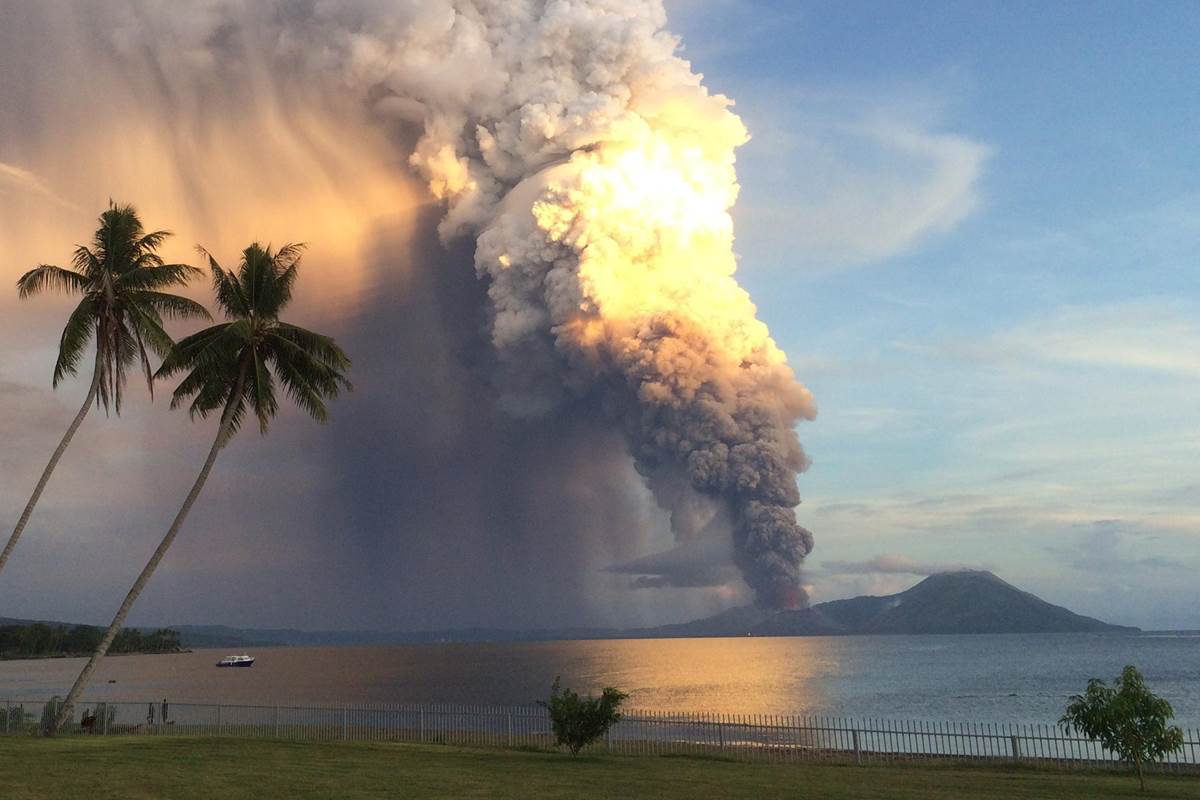Image: Mount Tavurvur erupting in Rabaul on August 29, 2014, spewing rocks and ash into the air, forcing the evacuation of local communities and international flights to be re-routed. OLIVER BLUETT / AFP – Getty Images
Papua New Guinea sits right along the edge of a collective ring of volcanoes called the ‘Pacific Ring of Fire.’
As such, PNG is home to some of the most dangerously active volcanoes in the Pacific region.
According to the National Disaster Centre, PNG has about 16 active volcanoes whilst at least 28 are either potentially active or dormant.
The 28 potentially active or dormant volcanoes could be cause for much greater concern for those living in, or around, areas where these volcanoes are located.
In actual figures, about a quarter of a million people living in a total area of 16, 000 square kilometres could possibly be affected by these volcanoes.
Volcanic eruptions have contributed in one way or another to population displacement in PNG as well as a number of fatalities.
Measures can be taken to minimise the damaging effects of volcanic eruptions.
POTENTIAL VOLCANIC ERUPTION – SIGNS TO LOOK OUT FOR
- slow fluctuations in ground swelling and collapse
- Continuous earth tremors
- Continuous increase of seismic activity
- Release of gas (Increases of gas activity or a change in the temperature of gases also can signify a potential eruption)
- Magma rising from the volcano
- significant rise in observed surface temperatures within the caldera or close to it
WHAT TO DO IF A VOLCANO ERUPTS
- Follow the evacuation order issued by authorities and evacuate immediately from the volcano area to avoid flying debris, hot gases, lateral blast and lava flow
- Be aware of mudflows. The danger from a mudflow increases near stream channels and with prolonged heavy rains. Mudflows can move faster than you can walk or run. Look upstream before crossing a bridge and do not cross the bridge if a mudflow is approaching.
- Avoid river valleys and low-lying areas.
- Remember to help your neighbors who may require special assistance – infants, elderly people and people with access and functional needs
Protection From Falling Ash
- If you are unable to evacuate, and in order to protect yourself from falling ash, you should remain indoors with doors, windows and ventilation closed until the ash settles.
- If you have a respiratory ailment, avoid contact with any amount of ash. Stay indoors until local health officials advise it is safe to go outside.
- Listen to a battery-powered radio or television for the latest emergency information.
- Wear long-sleeved shirts and long pants.
- Use goggles and wear eyeglasses instead of contact lenses.
- Use a dust mask or hold a damp cloth over your face to help with breathing.
- Stay away from areas downwind from the volcano to avoid volcanic ash.
- Stay indoors until the ash has settled unless there is a danger of the roof collapsing.
- Close doors, windows, and all ventilation in the house (air conditioners, fans and other vents)
- Clear heavy ash from flat or low-pitched roofs and rain gutters.
- Avoid running car or truck engines. Driving can stir up volcanic ash that can clog engines, damage moving parts, and stall vehicles.
- Avoid driving in heavy ash fall unless absolutely required. If you have to drive, keep speed down to 40KM/H or slower
See the Papua New Guinea: composite hazard map below which illustrates Papua New Guinea’s exposure to seismic, volcanic and tropical storm hazard.
Source: United Nations Office for the Coordination of Humanitarian Affairs – Regional Office for Asia and the Pacific (OCHA ROAP)Earthquake intensity zones indicate where there is a 20% probability that degrees of intensity shown on the map will be exceeded in 50 years; tropical storm intensity zones indicate where there is a 10% probability of a storm of this intensity striking in the next 10 years.
The map is based on data provided by: UN Cartographic Section, Global Discovery,FAO, Smithsonian Institute, Pacific Disaster Center, UNISYS, Munich Reinsurance.
See more:
Volcanos in Papua New Guinea
https://www.volcanodiscovery.com/papua-new-guinea.html
How do Scientists know a Volcano is about to erupt
http://www.livescience.com/8809-scientists-volcano-erupt.html


